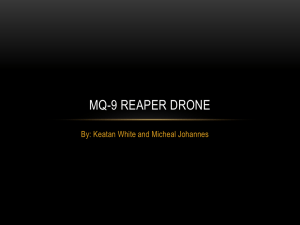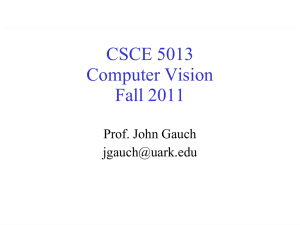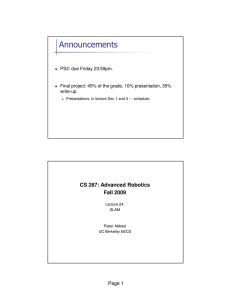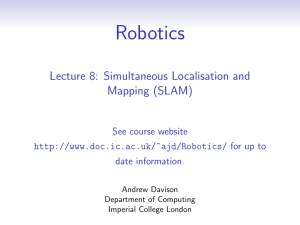Active SLAM in Structured Environments
advertisement
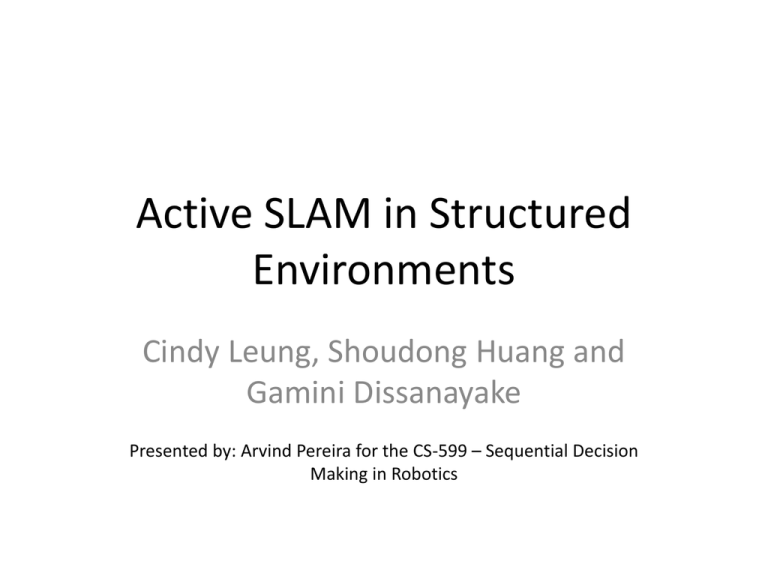
Active SLAM in Structured Environments Cindy Leung, Shoudong Huang and Gamini Dissanayake Presented by: Arvind Pereira for the CS-599 – Sequential Decision Making in Robotics Active SLAM Problem Definition Plan a trajectory for the robot such that : • Line features in the environment can be estimated accurately and efficiently • Requires an estimation algorithm for line features and robot poses using the observations and process information Line Representation • Active SLAM in this work is performed using “line features” as opposed to “point features” • Equation of line used: • For each line feature, several line segments may be found, and stored as: • Array stored but not included in SLAM state vector Observation Model • General Observation Model is: Process Model velocity Turn-rate Stabilizing noise added to cov. of robot pose for Unmodelled Process noise Incremental SLAM • Relative Position between observations • SLAM as a Least-squares problem Incremental SLAM contd… • The first part is the Process Innovation: Jacobians of Relative position equation • Odometry Prediction error Initial guess of the robot poses iSAM contd… • The second part is the Observation Innovation Jacobians of Observation Equation • Measurement prediction error Intial guess of the feature observed Solve a Linearized Least Squares Problem: Noise covariances can be expressed as : A contains the jacobians, b contains the innovations. Repeatedly solve the linearized least squares process until the solution has converged until is < Threshold Data-Association • Performed by extracting EKF state and covariance from iSAM state vector and A • To get the covariance P – Find the information matrix – Compute Covariance • The EKF state and its covariance are extracted using the current robot pose and all features. Using these values, standard nearest neighbor method is applied for data-association Trajectory Planning (1)- MPC • Primary objective is to minimize the uncertainty of the estimate • Cannot use Optimal control with fixed models due to uncertainties! • Model Predictive Control (MPC) with an attractor is used as the optimization strategy • Multi-step control optimization for MPC uses EKF algorithm while current estimate for MPC comes from iSAM Trajectory Planning (1) contd… • Obstacle avoidance is performed by using the current laser scan and doesn’t rely upon the SLAM output (since not all obstacles are necessarily lines!) • Makes sense because the range of the sensor is much larger than the planning horizon of the robot Line segment prediction • The control is based upon Information gain, and hence needs a means of predicting line segments which might be observed • Can be done using the predicted robot pose and the line segments • If robot is predicted to observe an adequate number of sensor measurements to an estimated line feature, that line is observed! • Covariance of the predicted line observation is predicted by simulating noises in range measurements associated with the line feature Trajectory Planning (2) - Attractor • Attractor is a virtual point feature • Attractor leads the robot toward a reference point where the robot should be heading to • It is placed at the first cell on the occupancy grid which is visible to the robot Reference Point for Exploration • An occupancy grid is also used to determine frontiers for exploration and traversable areas • A reference point for localization is one used in the explore state when frontier points are extracted from the occupancy grid • The frontier region is selected based upon minimum absolute bearing to the robot – used to minimize turning Reference Point for Localization and Mapping • Reference point for localization is usually a well defined feature • Mapping reference points are those with poorly defined features • Determined by thresholding covariances of features of interest • Once a group of potential reference points are obtained, the distance transform is computed for the occupancy grid map and the reference point is selected based upon minimum traversable distance Simulation Results Comparison of MPC+A, MPC and RS Experimental Results Loop and Timing characteristics


